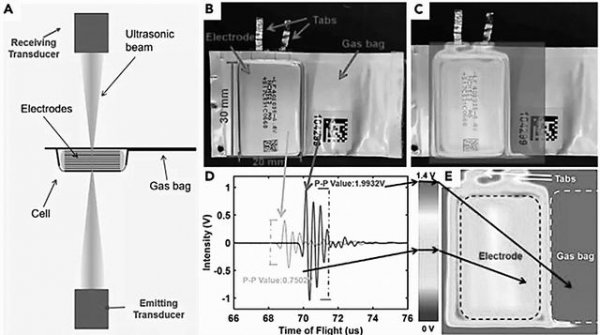
Principle Description of Ultrasonic Scanner
Lithium-ion batteries are the most successful energy storage devices in mobile electronics, electric vehicles and large energy storage stations. However, lithium-ion batteries still face challenges in terms of energy density, cycle life, and safety. In recent years, many new characterization methods have been applied to the research of lithium-ion batteries, but non-destructive in-situ inspection methods that can characterize the internal structure of soft pack batteries are still rare. At present, there is an urgent need for cheap, convenient, and rapid characterization methods to study the relative changes of electrolyte and gas in lithium-ion batteries, which will help improve the safety of lithium-ion batteries.
Recently, Professor Jeff. R. Dahn of Dalhousie University in Canada, Professor Huang Yunhui of Huazhong University of Science and Technology, and Associate Professor Shen Yue jointly published an article on "Joule" to study the use of a new type of ultrasonic scanner designed and manufactured by ourselves to measure the local ultrasound of soft pack batteries. Transmittance and use it for imaging. This ultrasonic imaging technology can clearly observe the wetting process of the battery, which can be used as a very sensitive method to detect the failure mechanism of lithium-ion soft-pack batteries.
According to the content of the paper, ultrasonic waves are emitted from the focusing transducer on one side, penetrate the battery, and are received by another transducer on the other side. In the focused ultrasound beam path, changes in the physical properties of the material will affect the transmitted ultrasound signal. Since ultrasound is a mechanical wave, it needs a medium to propagate. The electrodes in a battery can be regarded as closely packed particles. When the electrodes are dry, ultrasonic waves can only propagate through direct contact between the particles. These irregular particles will produce a lot of reflection and refraction, leading to rapid attenuation of the ultrasound signal. Most of the energy of ultrasound is consumed by the friction between these particles. However, if the electrode is wetted by the electrolyte, the electrolyte can act as a medium for acoustic waves and provide an additional path for the propagation of ultrasonic waves. Therefore, ultrasound imaging is very sensitive to the wetting state of lithium ion batteries and can be used to study the dryness and "non-wetting" of lithium ion batteries.
The ultrasonic imaging technology developed by the researchers is a very useful non-destructive testing method that can be used to check the electrolyte and/or gas state of the soft pack battery. Ultrasonic transmission imaging can quickly determine the minimum electrolyte injection volume and wetting time of the battery, which helps to optimize the battery manufacturing process. Therefore, this technology can be used to study battery aging and find evidence of electrolyte drying or "not wetting" without disassembling the battery. (Li Muzi)
Hydraulic main pump,High Quality Hydraulic main pump,Hydraulic main pump Details, CN
Jining Juheng Hydraulic Machinery Co., Ltd. , https://www.juheng-cn.com